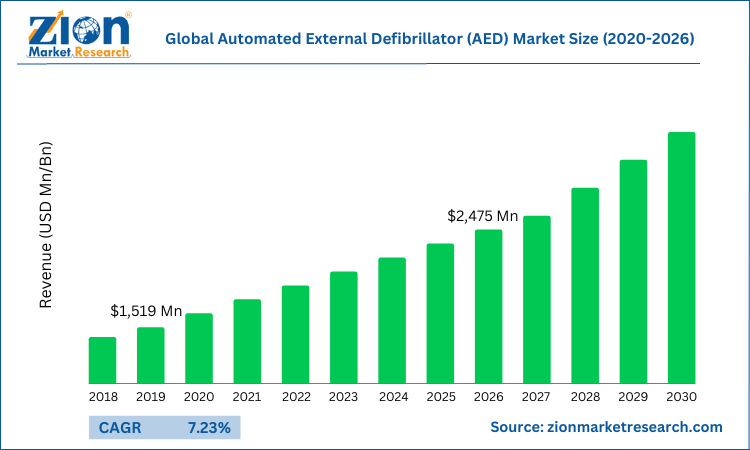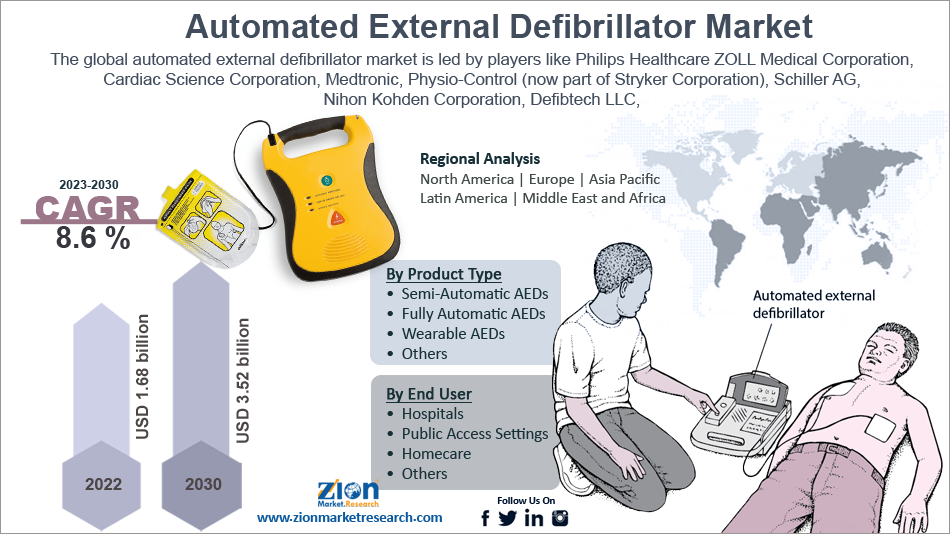Global Automated External Defibrillator Market Size, Share, Growth Analysis Report - Forecast 2034

Automated External Defibrillator Market By Product (Fully-automated, Semi-automated), By End-use (Hospital, Pre Hospital, Public Access Market, Alternate Care Market, Home Healthcare), and By Region: Global and Regional Industry Overview, Market Intelligence, Comprehensive Analysis, Historical Data, and Forecasts 2025 - 2034
| Market Size in 2024 | Market Forecast in 2034 | CAGR (in %) | Base Year |
|---|---|---|---|
| USD 1.99 Billion | USD 4.64 Billion | 8.83% | 2024 |
Automated External Defibrillator Industry Perspective:
The global automated external defibrillator market size was worth around USD 1.99 Billion in 2024 and is predicted to grow to around USD 4.64 Billion by 2034 with a compound annual growth rate (CAGR) of roughly 8.83% between 2025 and 2034. The report analyzes the global automated external defibrillator market's drivers, restraints/challenges, and the effect they have on the demands during the projection period. In addition, the report explores emerging opportunities in the automated external defibrillator industry.
Automated External Defibrillator Market: Overview
An automated external defibrillator (AED) is a portable medical device used to treat individuals experiencing sudden cardiac arrest (SCA). Sudden Cardiac Arrest (SCA) is a life-threatening condition characterized by the sudden and abrupt cessation of effective heart rhythm. The primary purpose of an AED is to deliver an electrical shock, known as defibrillation, to the heart in order to restore its normal rhythm and potentially save the person's life. AEDs are designed to be easily portable and accessible, allowing them to be quickly brought to the location where they are needed. They are commonly found in public spaces, such as airports, shopping malls, schools, and sports stadiums, as well as in healthcare settings like hospitals and ambulances. Overall, AEDs are critical tools in the management of sudden cardiac arrest. Their portability, ease of use, and ability to analyze heart rhythms make them valuable in providing timely and potentially life-saving interventions during emergencies.
Key Insights
- As per the analysis shared by our research analyst, the global automated external defibrillator market is estimated to grow annually at a CAGR of around 8.83% over the forecast period (2025-2034).
- Regarding revenue, the global automated external defibrillator market size was valued at around USD 1.99 Billion in 2024 and is projected to reach USD 4.64 Billion by 2034.
- The automated external defibrillator market is projected to grow at a significant rate due to rising incidences of sudden cardiac arrests, increasing public-access AED programs, and growing emphasis on workplace and community safety.
- Based on Product, the Fully-automated segment is expected to lead the global market.
- On the basis of End-use, the Hospital segment is growing at a high rate and will continue to dominate the global market.
- Based on region, North America is predicted to dominate the global market during the forecast period.
Automated External Defibrillator Market: Growth Drivers
Increasing awareness and emphasis on public access defibrillation (PAD) programs.
There has been a growing recognition of the vital role of early defibrillation in improving survival rates for individuals experiencing sudden cardiac arrest (SCA). PAD programs are designed to make AEDs readily available in public spaces, workplaces, and other high-traffic areas where cardiac emergencies are likely to occur. The implementation of PAD programs involves strategically placing AEDs in easily accessible locations, accompanied by training individuals in cardiopulmonary resuscitation (CPR) and AED usage. These programs have gained momentum due to several factors. First, there has been an increase in the incidence of SCA, making it a significant public health concern. Second, there is a growing awareness among the general population about the importance of immediate defibrillation in saving lives. People are now more informed about the fact that prompt access to an AED and early defibrillation greatly enhances the chances of survival. Advancements in AED technology have also contributed to the growth of PAD programs.
AEDs have become more user-friendly, portable, and affordable, making them suitable for deployment in public access settings. These devices now feature enhanced rhythm analysis algorithms, clear voice & visual prompts, and connectivity options for data transmission and remote monitoring. These technological advancements have increased the effectiveness and ease of use of AEDs, further supporting the implementation of PAD programs.
Automated External Defibrillator Market: Restraints
The cost associated with AED devices
The cost of AED devices can pose a challenge to the automated external defibrillator industry growth, particularly for smaller organizations or budget-constrained entities that may struggle to allocate resources for purchasing AEDs. For example, community organizations, schools, or public spaces with limited funding may find it difficult to afford multiple AED units to cover their desired areas. In addition to the initial cost of purchasing AED devices, there are ongoing maintenance and replacement costs to consider. AEDs require regular maintenance, including battery replacements, electrode pad replacements, and overall device upkeep to ensure their optimal performance. These maintenance activities may involve additional costs that need to be factored into the overall budget of organizations implementing AED programs.
Automated External Defibrillator Market: Opportunities
Increasing focus on public access defibrillation (PAD) programs.
Public access defibrillation refers to the strategic placement of AEDs in public spaces to ensure rapid access and early defibrillation for individuals experiencing sudden cardiac arrest (SCA). This approach recognizes the critical role of immediate defibrillation in improving survival rates. Governments, healthcare organizations, and community groups are increasingly recognizing the importance of PAD programs in saving lives. There is a growing emphasis on deploying AEDs in public places such as airports, train stations, shopping malls, sports arenas, schools, and other high-traffic areas. this presents a significant opportunity for AED manufacturers and providers to supply devices for these programs, thereby driving the automated external defibrillator market expansion.
Automated External Defibrillator Market: Challenges
Lack of training and education for potential users
Many potential users, including bystanders or non-medical personnel, may not be aware of the importance of AEDs or how to use them. increasing public awareness about AEDs and providing accessible training opportunities is essential to empower individuals to take action during cardiac emergencies.
Automated External Defibrillator Market: Segmentation
The global automated external defibrillator market is segmented based on product type, end-user, distribution channel, and region.
Based on the product type, the global market segments are semi-automatic AEDs, fully automatic AEDs, wearable AEDs, and others. The fully automatic AED segment captures the highest market share during the forecast period. In contrast to semi-automatic AEDs that necessitate the user to press the button to administer a shock, fully automatic AEDs are specifically engineered to evaluate the heart's rhythm and, if deemed necessary, administer a shock without any user intervention. Upon detecting a shockable rhythm, the AED automatically charges and administers the requisite electrical shock to the patient.
Based on end users, the global market is bifurcated into hospitals, public access settings, home care, and others. The hospital segment captures the highest market share during the forecast period. hospitals often have a higher adoption rate of AEDs due to their role as healthcare institutions with trained medical staff. AEDs are commonly used in hospital settings, including emergency departments, cardiac units, and critical care units, to provide immediate defibrillation during cardiac emergencies. Hospitals are equipped with comprehensive resuscitation protocols and have trained personnel who can effectively use AEDs, contributing to their higher market share.
Based on distribution channels, the global market segments are bifurcated into online retailers, offline retailers, direct sales, and others. The direct sales segment captures the highest market share during the forecast period. some manufacturers or distributors may opt for direct sales, where they sell AEDs directly to customers without involving intermediaries. This distribution channel allows manufacturers to have direct control over the sales process, customer relationships, and after-sales service.
Recent Developments:
- In December 2020, Philips, a leading healthcare technology company, completed its acquisition of Biotelemetry, a remote cardiac monitoring and diagnostic solutions provider. This acquisition expanded Philips' capabilities in the cardiac care space, including the AED market.
- In 2020, Stryker Corporation, a prominent medical technology company, completed the acquisition of Physio-Control, a leading manufacturer of AEDs and emergency medical response products. This acquisition further strengthened Stryker's portfolio in emergency medical care and resuscitation.
Automated External Defibrillator Market: Report Scope
| Report Attributes | Report Details |
|---|---|
| Report Name | Automated External Defibrillator Market |
| Market Size in 2024 | USD 1.99 Billion |
| Market Forecast in 2034 | USD 4.64 Billion |
| Growth Rate | CAGR of 8.83% |
| Number of Pages | 215 |
| Key Companies Covered | Nihon Kohden Corporation, Koninklijke Philips N.V., Progetti S.r.l., MS Westfalia GmbH, AMI Italia S.r.l., Silverline Meditech Pvt. Ltd., CU Medical Systems, Inc., Corpuls, BPL Medical Technologies, Corpuls, Physio-Control, HeartSine, Cardiac Science, Defibtech, Philips, and others. |
| Segments Covered | By Product, By End-use, and By Region |
| Regions Covered | North America, Europe, Asia Pacific (APAC), Latin America, The Middle East and Africa (MEA) |
| Base Year | 2024 |
| Historical Year | 2020 to 2023 |
| Forecast Year | 2025 - 2034 |
| Customization Scope | Avail customized purchase options to meet your exact research needs. Request For Customization |
Automated External Defibrillator Market: Regional Analysis
North America is expected to dominate the market during the forecast period
North America, particularly the United States, has been one of the leading markets for AEDs. The region has witnessed widespread AED implementation in various settings, including hospitals, public spaces, and homes. Factors such as strong healthcare infrastructure, favorable reimbursement policies, increased awareness, and robust public access defibrillation (PAD) programs have contributed to the high market share in this region.
Europe has also witnessed substantial adoption of AEDs, with countries like the United Kingdom, Germany, and France leading the automated external defibrillator market. The region has implemented comprehensive PAD programs and regulations, making AEDs more accessible in public spaces. Additionally, there has been an emphasis on increasing AED deployment in healthcare facilities and improving public awareness of CPR and AED usage.
Automated External Defibrillator Market: Competitive Analysis
The report provides a company market share analysis to give a broader overview of the key market players. In addition, the report also covers key strategic developments of the market, including acquisitions & mergers, new product launches, agreements, partnerships, collaborations & joint ventures, research & development, and regional expansion of major participants involved in the automated external defibrillator market on a global and regional basis.
The global automated external defibrillator market is dominated by players like:
- Nihon Kohden Corporation
- Koninklijke Philips N.V.
- Progetti S.r.l.
- MS Westfalia GmbH
- AMI Italia S.r.l.
- Silverline Meditech Pvt. Ltd.
- CU Medical Systems Inc.
- Corpuls
- BPL Medical Technologies
- Corpuls
- Physio-Control
- HeartSine
- Cardiac Science
- Defibtech
- Philips
The global automated external defibrillator market is segmented as follows;
By Product
- Fully-automated
- Semi-automated
By End-use
- Hospital
- Pre Hospital
- Public Access Market
- Alternate Care Market
- Home Healthcare
By Region
- North America
- The U.S.
- Canada
- Mexico
- Europe
- France
- The UK
- Spain
- Germany
- Italy
- Rest of Europe
- Asia Pacific
- China
- Japan
- India
- Australia
- South Korea
- Rest of Asia Pacific
- The Middle East & Africa
- Saudi Arabia
- UAE
- Egypt
- Kuwait
- South Africa
- Rest of the Middle East & Africa
- Latin America
- Brazil
- Argentina
- Rest of Latin America
Table Of Content
Methodology
FrequentlyAsked Questions
An automated external defibrillator (AED) is a portable medical device used to treat individuals experiencing sudden cardiac arrest (SCA). SCA is a life-threatening condition in which the heart suddenly stops beating effectively, often due to an electrical problem in the heart. The primary purpose of an AED is to deliver an electrical shock, known as defibrillation, to the heart in order to restore its normal rhythm and potentially save the person's life.
The global automated external defibrillator market is expected to grow due to increasing public awareness and government initiatives for AED installation in public places, rising incidence of sudden cardiac arrest (SCA) and cardiovascular diseases, and continuous technological advancements making devices more user-friendly and effective.
According to a study, the global automated external defibrillator market size was worth around USD 1.99 Billion in 2024 and is expected to reach USD 4.64 Billion by 2034.
The global automated external defibrillator market is expected to grow at a CAGR of 8.83% during the forecast period.
North America is expected to dominate the automated external defibrillator market over the forecast period.
Leading players in the global automated external defibrillator market include Nihon Kohden Corporation, Koninklijke Philips N.V., Progetti S.r.l., MS Westfalia GmbH, AMI Italia S.r.l., Silverline Meditech Pvt. Ltd., CU Medical Systems, Inc., Corpuls, BPL Medical Technologies, Corpuls, Physio-Control, HeartSine, Cardiac Science, Defibtech, Philips, among others.
The report explores crucial aspects of the automated external defibrillator market, including a detailed discussion of existing growth factors and restraints, while also examining future growth opportunities and challenges that impact the market.
RelatedNews
HappyClients
Zion Market Research
Tel: +1 (302) 444-0166
USA/Canada Toll Free No.+1 (855) 465-4651
3rd Floor,
Mrunal Paradise, Opp Maharaja Hotel,
Pimple Gurav, Pune 411061,
Maharashtra, India
Phone No +91 7768 006 007, +91 7768 006 008
US OFFICE NO +1 (302) 444-0166
US/CAN TOLL FREE +1 (855) 465-4651
Email: sales@zionmarketresearch.com
We have secured system to process your transaction.
Our support available to help you 24 hours a day, five days a week.
Monday - Friday: 9AM - 6PM
Saturday - Sunday: Closed






